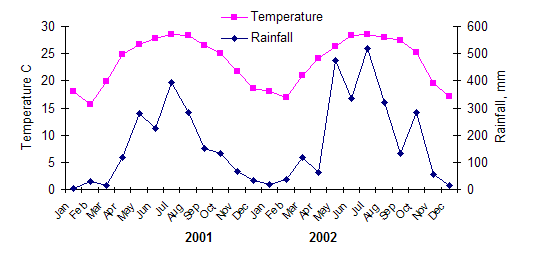
This experiment was carried out at the Goat and
Rabbit Research Center, Sontay, Hatay, Vietnam from February 2001 to November 2002
to study effects of associations of Flemingia with Cassava and Mulberry on
biomass yield and soil fertility of sloping land.
Yield of DM and crude protein was highest for the association of cassava with Flemingia, followed by Flemingia alone. Soil fertility, as measured by the “biotest” method (relative growth of maize plants in soil from experimental plots), was highest for the association of Flemingia with cassava, followed by Flemingia alone, with lowest values for cassava and mulberry in monoculture. There was a close relationship between the soil “biotest” and the DM yield of the crops.
Bavi district is located in the West of Hatay, North Vietnam. The area is hilly to mountainous and 80% is sloping land. Due to this topography the intensity of land use is not high. The district comprises 421 km² of which about 14,900 ha (149 km²) are used for agricultural purposes. Although agriculture and forestry are the main activities in the district, around 12,100 ha are used for crop production. The district consists of 32 villages and about 233,000 inhabitants. Seven of these villages are among the poorest in Vietnam. The traditional farming in the district is based on production of rice, cassava roots, fruit trees, vegetables and eucalyptus. Crop yields in general are low due to extensive cropping systems with low inputs of fertilisers and other agrochemicals.
Slopping land is generally of poor fertility and prone to widespread erosion within the district (Dinh Van Binh, personal communication). Almost all families keep livestock, with pigs, chickens, fish and ducks being the most common. Cattle and buffalo are kept mainly for draught purposes, both for land preparation and transport. Crop residues such as rice straw play a dominant role as feed resources for these animals supplemented with grazing and cut grasses from edges of roads, fields and ponds. In tree cropping areas the most important feeds consist of leaves and branches from the trees.
Flemingia (Flemingia macrophylla) is a leguminous shrub with high biomass yields that grows well on acid soil. It is reasonably tolerant of drought. Cassava is a perennial woody shrub native of tropical south America, it is grown in most tropical countries and important food in many part of the world. It is also well adapted to acid soils, and is tolerant of soil pH as low as 4.6 and aluminium saturation up to 80%. Mulberry (Morus alba) can grow to a large tree up to 15m high, with an umbrella shaped crown. It is native to China and it's leaves have long functioned as the feed for silkworms. The tree also provides timber and delicious fruit.
The studies reported here are focused on increasing biomass production and the sustainability of cropping systems. The specific objective of the study was to evaluate contrasting cropping systems for sloping, hilly land, comparing associations of cassava and Flemingia, Mulberry and Flemingia, and cassava and Mulberry in monculture.
The experiment was carried out from February 2001 to November 2002 on sloping land in the Bavi area, Hatay province, North Vietnam. The soil composition at the experimental site was pHKCl 3.70, organic matter 5.00 %, Ntotal 0.18%, P2O5 total 1.12 %, K2Ototal 0.16%. The soil is acid with low fertility. The climate in the area is monsoon-tropical, with a wet season between April and November and the dry season from December to March (Figure 1).

Figure 1.
Climate in Bavi district
(data from Bavi climate station)
The mean annual air temperature in 2000 was 23.5 ºC and in 2001, 23.3ºC
The treatments were: Cassava for foliage in monculture, Cassava intercropped with Flemingia (CF), Flemingia in monoculture (F), Mulberry in monoculture (M), Mulberry inter-cropped with Flemingia (MF). The arrangement of the treatments in 3 blocks are indicated in Table 1. The experimental plots were each 10*10 m (100 m²) arranged as a randomized complete block design with 3 replications.
|
Table
1. The layout of
the experiment |
|||||||
|
|
Slope |
Treatment plots |
|||||
Block 1
|
↓ ↓ ↓ |
|
F |
MF |
CF |
M |
|
|
Block 2 |
MF |
CF |
M |
C |
F |
||
|
Block 3 |
|
C |
F |
M F |
CF |
||
The cassava and Mulberry were planted with stem cuttings (20 to 25 cm long) in rows separated by 50 cm. The cassava cuttings were laid in a shallow furrow and covered with soil; the Mulberry cuttings were inserted in the soil with 10cm in the soil and the remainder above ground. For the association of cassava and Flemingia, plaznting was in altrnate rows 50 cm apart. Flemingia was planted from seed at 5 cm spacing between seeds. The pure stand of Flemingia was planted with 50 cm between rows (5 cm spacing between seeds). Flemingia was planted first and cassava and mulberry 14 days later. Only organic manure was applied at the rate of 2 kg/m² before planting in the first year and the same amount again in March the second year. No other fertilizers were applied during the experimental period.
The first harvest was made when the cassava reached 100 cm in height (about 3 months after planting). All the foliage was removed at 30 cm above ground level. The same pattern was followed for the re-growth (after from 56 to 75 days). In the associated plot and in the pure stands, Flemingia and Mulberry were harvested at 30 cm above ground level at the same time as the cassava.
|
|
|
| Figure 1a: Association of Cassava and Flemingia after harvesting the cassava (Flemingia not yet harvested) (about 4 months after planting) | Figure 1b: Association of Mulberry and Flemingia one month after after harvesting both species (About 8 months after planting) |
The fresh biomass was weighed at each harvest for each species separately. Samples were taken from the edible fraction of the foliage of cassava, Mulberry and Flemingia at each harvest and at the end of the year; samples of the roots as by-product were taken in the plots with cassava at the end of the second year.
The foliage samples were analysed for DM, N, ash and ADF according to AOAC (1990). NDF was determined by the method of Van Soest et al (1991. Soil samples were analysed for pHKCl, organic matter, N, P and K (Hanoi Soil Fertility Institute).
All data were analysed by Analysis of Variance using the General Line Model procedure of Minitab Software (Minitab, 2000). The treatment means which showed significant differences at the probability level of P<0.05 were compared with each other using Tukey’s pair-wise comparison procedure.
The statistical model used in the
analysis was:
Yij = µ + Ti +Bj + (TB)ij + eij
Where: Yij : Dependent variable; µ overall mean; Ti treatment effect, Bj block effect; (TB)ij interaction between treatment and block; eij experimental error.
The DM values of Flemingia and cassava
foliage were higher than for Mulberry foliage. The
crude protein in Flemingia was 14.6% and lower
than the values reported by
Dinh Van Binh et al (1998) and Nguyen Thi Mui et al (2002).
|
Table
2. Chemical
composition of the foliages and cassava root
|
||||
|
|
Flemingia |
Mulberry |
Cassava |
Cassava roots |
|
Number
samples |
6 |
6 |
6 |
3 |
|
DM, g/kg |
249±3.5 |
171.5±1.8 |
203±3.8 |
401±5.8 |
|
CP, g/kg DM |
146±2.0 |
169±3.1 |
167±2.1 |
27±3.3 |
|
Ash, g/kg DM |
64±1.1 |
87±1.5 |
64±1.2 |
19±1.7 |
|
NDF, g/kg DM |
627±11.2 |
346±7.5 |
487±11.2 |
29±1.4 |
|
ADF, g/kg DM |
515±8.9 |
209±3.4 |
372±8.9 |
15±1.4 |
|
Table 3. Mean yields of biomass DM and crude protein in each or the two years |
|||||||
|
|
C |
M |
Flemingia |
Cassava-Flemingia |
Mulberry-Flemingia |
SE |
|
|
Year 2000 |
|
|
|
|
|
|
|
DM,
tonnes/ha
|
7.14b |
2.58d |
4.68c |
7.66a |
4.86c |
0.198 |
|
|
Cassava |
7.14 |
- |
- |
5.94 |
- |
|
|
|
Mulberry |
- |
2.58 |
- |
- |
1.86 |
|
|
|
Flemingia |
- |
- |
4.68 |
1.72 |
2.99 |
|
|
CP,
tonnes/ha
|
1.20a |
0.44c |
0.68b |
1.26a |
0.75b |
0.032 |
|
|
Cassava |
1.21 |
- |
- |
1.00 |
- |
|
|
|
Mulberry |
- |
0.43 |
- |
- |
0.31 |
|
|
|
Flemingia |
- |
- |
0.68 |
0.25 |
0.44 |
|
|
|
Year 2001 |
|
|
|
|
|
|
|
DM,
tonnes/ha
|
7.22c |
3.30d |
11.21a |
11.83a |
9.57b |
0.195 |
|
|
Cassava |
5.47 |
|
|
4.57 |
|
|
|
|
Mulberry |
|
3.30 |
|
|
|
|
|
|
Flemingia |
|
|
11.21 |
5.94 |
7.54 |
|
|
|
Cassava
root |
1.75 |
|
|
1.32 |
|
|
|
CP,
tonnes/ha
|
0.97c |
0.56d |
1.64a |
1.68a |
1.45b |
0.029 |
|
|
Cssava |
0.93 |
|
|
0.77 |
|
|
|
|
Mulberry |
|
0.56 |
|
|
0.35 |
|
|
|
Flemingia |
|
|
1.64 |
0.87 |
1.10 |
|
|
|
Cassava
root |
0.04 |
|
|
0.03 |
|
|
|
|
Two year |
|
|
|
|
|||
|
DM |
14.4c |
5.88d |
15.9b |
19.5a |
14.4c |
0.328 |
|
|
CP |
2.18c |
1.00d |
2.33b |
2.94a |
2.20c |
0.051 |
|
|
a b cd
Means within rows with different superscripts differ at P<0.05
|
|||||||
Cassava plots in monoculture or associated with
Flemingia had highest biomass and crude protein yield in the first year (Table 3; Figures 2 and 3). Flemingia and Mulberry in monoculture or in
association had the lowest yields in year 1. In year 2 the yield of Flemingia in
monoculture was twice that in year 1 and similar to that of the association of
cassava-mulberry. ![]()
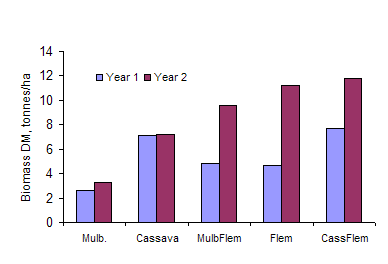
Figure 2:
Biomass DM yields of cassava, mulberry and Flemingia in monoculture or as associations
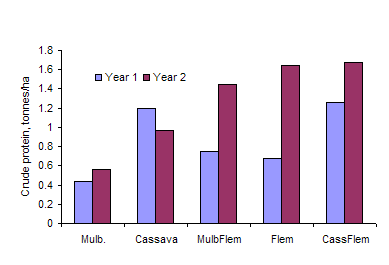
Figure 3:
Crude protein yields of cassava, mulberry and Flemingia in monoculture or as associations
The maize biotest data (Table 4; Figure 4) show that the differences in
soil fertility between the treatments became more marked with time after
planting, with the plots containing Flemingia in monoculture or association
being significantly better than the cassava and mulberry grown in monoculture. As the tests were carried out under
different climatic conditions the absolute values reflect more the effect of
time of year then the intrinsic fertility of the soil.
|
Table
4. Weight of roots
plus green biomass of maize plants grown in soil from the experimental
plots |
||||||
|
|
C |
M |
F |
CF |
MF |
SE |
Beginning
|
20.0 |
20.2 |
19.6 |
20.4 |
19.0 |
0.35 |
|
6 months |
21.2 |
20.2 |
20.7 |
23.4 |
19.8 |
0.27 |
|
12
months |
21.3b |
22.1b |
22.1b |
25.9a |
22.4b |
0.33 |
|
18
months |
23.7c |
22.1d |
27.2b |
27.9a |
27.1b |
0.48 |
24 months
|
25.0d |
23.6e |
28.3b |
32.0a |
27.3c |
0.45 |
|
a b cde Means within rows with different superscripts differ at P<0.05 |
||||||
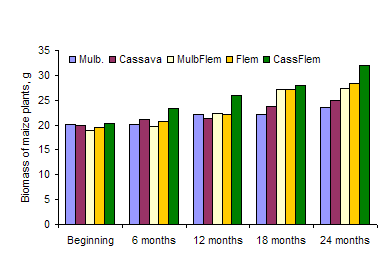
Figure 4:
Yield of maize biomass in soil samples from the experimental plots, taken
at the beginning, and after 6, 12, 18 and 24 months.
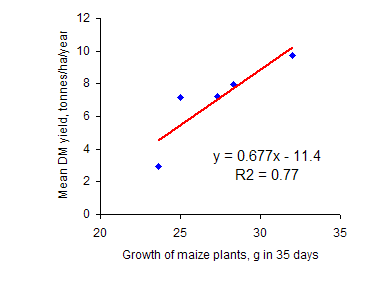
Figure 5:
Relationship between the maize "biotest"and the
biomass yield of the
experimental treatments in the second year
The data for the chemical parameters of the soil wereles consistent thatn those for the maize biotest. Most criteia, other than the P content, favoured the Flemingia monoculture plots (Table 5).
|
Table 5: Chemical parameters of the soils at the beginning and the end of the second year |
|||||
|
|
pHKCl |
OM, % |
N total, % |
P2O5, % |
K2O, % |
Beginning |
3.70 |
5.00b |
0.176b |
1.12d |
0.161a |
|
After 2 years |
|
|
|
||
|
Cassava |
3.76 |
4.76c |
0.156c |
1.46bc |
0.077b |
|
Mulberry |
3.73 |
4.80bc |
0.156c |
2.10a |
0.080b |
|
Mulberry-Flemingia |
3.76 |
4.60d |
0.163bc |
1.50b |
0.073b |
Cassava-Flemingia |
3.76 |
4.90b |
0.170b |
1.35c |
0.083b |
|
Flemingia |
3.80 |
5.20a |
0.200a |
1.66b |
0.083b |
|
SEM |
0.029 |
0.175 |
0.0106 |
0.199 |
0.0061 |
|
a b cd Means within columns with different superscripts differ at P<0.05 |
|||||
When cassava
This study was financed as part of
the SAREC bilateral Technical Assistance Programme (1992-2002) in Vietnam. We
wish to thank colleagues in the Goat and Rabbit
Research Centre for assistance with the management of the experiment and the
analysis of the data.
AOAC 1990 Official
methods of chemical analysis. Association of Official Agricultural Chemists.
(16th edition)
Dinh Van Binh, Nguyen Phuc Tien and Nguyen Thi Mui 1998 Study on biomass yield and quality of Flemingia macrophylla and on soil fertility. In: Proceedings of Workshop on Animal Nutrition Science, Ministry of Agriculture and Rural Development, Vietnam, pp.137
Nguyen Thi Mui, Ledin I, Udén P and Dinh Van Binh 2001 Effect of replacing a rice bran-soya bean concentrate with Jackfruit (Artocarpus heterophyllus) or Flemingia (Flemingia macrophylla) foliage on the performance of growing goats. Livestock Production Science 72, 253-262
Van Soest P J, Robertson J B and Lewis B A 1991. Methods for dietary fiber, neutral detergent fiber and non starch polysaccharides in relation to animal nutrition. Journal of Dairy Science 74:3583-3593